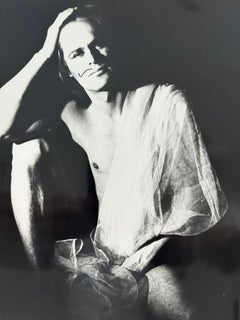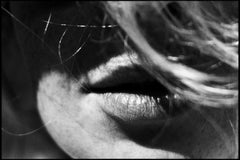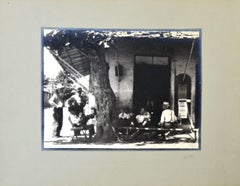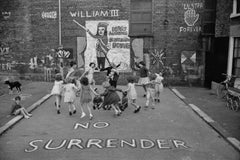Items Similar to Untitled, Motorcycle Bondage, San Francisco.
Want more images or videos?
Request additional images or videos from the seller
1 of 4
Fisher RossUntitled, Motorcycle Bondage, San Francisco.ca. 1978
ca. 1978
About the Item
Fisher Ross. Untitled, Image #5, ca. 1975-80. Offset print postcard format. 4.5 x 6.5 inches; 12 x 15 inches framed. Excellent condition.
Photographs from the archive of After Dark and Dance Magazine editor William Como. After Dark was an essential source on dance, theater, performance art, ballet, and cinema of the late 60 and 1970s and a foundational piece of gay cultural history that influenced a generation of artists.
Body By Fisher was a series of very limited run offset print postcards produced by the artist. Given their erotic content, they would have been available only in very select retail locations in The Castro. No surviving examples are known to exist other than those from the Como collection.
The 1980 Postcard depicted here (separate, not for sale) and sent to Como was prophetic as the entire estate of Ross was discarded/destroyed upon his death during the early days of the AIDS epidemic.
About the Seller
4.9
Platinum Seller
Premium sellers with a 4.7+ rating and 24-hour response times
Established in 2007
1stDibs seller since 2015
387 sales on 1stDibs
Typical response time: 3 hours
- ShippingRetrieving quote...Shipping from: Wilton Manors, FL
- Return Policy
Authenticity Guarantee
In the unlikely event there’s an issue with an item’s authenticity, contact us within 1 year for a full refund. DetailsMoney-Back Guarantee
If your item is not as described, is damaged in transit, or does not arrive, contact us within 7 days for a full refund. Details24-Hour Cancellation
You have a 24-hour grace period in which to reconsider your purchase, with no questions asked.Vetted Professional Sellers
Our world-class sellers must adhere to strict standards for service and quality, maintaining the integrity of our listings.Price-Match Guarantee
If you find that a seller listed the same item for a lower price elsewhere, we’ll match it.Trusted Global Delivery
Our best-in-class carrier network provides specialized shipping options worldwide, including custom delivery.More From This Seller
View AllPortriat of Tom Petchlsig
Located in Wilton Manors, FL
Victor Arimondi (1942-2001). Portrait of Tom Petchlsig, ca. 1975. Period print measures 8 x 10 inches; 16 x 20 inches frames. Artist studio stamp on ve...
Category
1970s Realist Black and White Photography
Materials
Photographic Paper
Untitled, Senegalese model
Located in Wilton Manors, FL
Victor Arimondi (1942-2001). Portrait of Senegalese Model, ca. 1975. Period print measures 8.5 x 11.5 inches; 17 x 20 inches frames. Artist studio stam...
Category
1970s Realist Black and White Photography
Materials
Photographic Paper
Portrait of Nude Man
Located in Wilton Manors, FL
Victor Arimondi (1942-2001). Portrait, ca. 1975. Period print measures 11 x 14 inches. Artist studio stamp on verso.
Victor Arimondi (November 8, 1942 – July 24, 2001) was an Italian American photographer and model who lived and worked in Europe before moving to the United States in the late 1970s. His early fashion photography, his portraits of Grace Jones and other artists, and his male nudes photographed in New York and San Francisco captured the pre-AIDS culture of the 1970s and early 1980s.
Arimondi's nudes were collected in several books, including David Leddick's award-winning[1] The Male Nude, (New York: Taschen 1998, 2005 and 2015). The photographer's later work documented homeless individuals in San Francisco's Tenderloin neighborhood and the toll of the AIDS epidemic on the city. His photographs, featured in several posthumous exhibitions, also are in the collections of Sweden's museum of modern art, Moderna Museet, and San Francisco's GLBT Historical Society.
Biography
Arimondi was born Vittorio Maria Tevitti to his unwed mother, Alessandra Calligaris, in Bologna, Italy on November 8, 1942. His mother struggled financially, which left an impression on her only child. In 1948, she temporarily left him at a children's boarding school and orphanage in Italy to move to Sweden for a job. There she met and married Bruno Arimondi, who adopted her son. The family returned to Naples, Italy in 1952 where Victor graduated from high school.[1]
In 1960, Arimondi returned to Sweden to study at the University College of Arts, Crafts and Design in Stockholm, although he did not graduate. Meanwhile, he worked at several blue collar jobs, including as a mailman, before he gave up on traditional full-time work to pursue what he considered more essential— a life of creative expression. He created costume-like clothing for himself and friends and at age 19 became a fashion model.
Even as a teenager, the Italian born photographer who spent his 20s and 30s primarily based in Sweden, noted that he preferred fantasy to the trials of real life.[1] That conflict, and his passion for beauty as well as his sexual energy, were major factors in his life and his work.[2]
From 1965 through 1972 Arimondi worked as model in London, Milan, Germany, New York and Stockholm, appearing in catalogs and fashion magazines including Vogue , Harper's Bazaar and Esquire and on the runway in several Valentino fashion shows.
In 1972 he decided to try working on the other side of the lens as a photographer to better express his creativity.[2]
Arimondi moved to New York in 1979 and continued to build his photography portfolio.
Portrait of Bearded Man, New York City, 1979
Two years later, in 1981, he moved to San Francisco where he lived and worked for twenty years until his death of AIDS at age 58 on July 24, 2001.
The year he moved to San Francisco, Arimondi opened a photo gallery in the Haight-Ashbury neighborhood for a short time. When he struggled financially, he gave up on trying to earn a living through commercial fashion photography and closed the gallery.[3]
Arimondi returned to modeling for the financial benefits, though he did so on less of an international scale than in his early years.
He continued to create photographic portraits of the denizens of the San Francisco gay and arts cultures, to shoot male nudes and publish his work in magazines, and he began to compose and photograph evocative still lifes using his own photographic images. Many of them touched on the death of dozens of his former photography models from AIDS.
Arimondi was in the midst of a new photography project that brought together his background as a fashion photographer and his more recent social documentary work when he died several months after he learned he was HIV-positive.[4] The project featured his former colleague, haute couture cover model Ivy Nicholson,[5] who he found living homeless in San Francisco. Several of the haunting portraits he took of her were later included in a noted group exhibit at SF Camerawork.
Art
Arimondi's early photography in the 1970s in Stockholm included portraits of the stars of Sweden's fashion, theater and dance worlds. His first two photography exhibits were in Stockholm and met with mixed reviews. But as he matured as a photographer and tapped into his fashion world contacts, Arimondi landed a number of commercial fashion jobs, including shooting for the Italian designer Salvatore Ferragamo S.p.A.'s I.Magnin department store ad that ran in Vogue.
Marlboro Man Nude, New York City,1980.
He also shot other artists and models for his own portfolio, including Grace Jones, the Norwegian actress, Liv Ullmann, and the American writer, Norman Mailer.
Arimondi's aesthetic vision was focused on fantasy and drama, and he prided himself on pushing limits.[6]
Although less well-known than his San Francisco contemporary...
Category
1970s Realist Black and White Photography
Materials
Photographic Paper
Portrait of Nude Man
Located in Wilton Manors, FL
Victor Arimondi (1942-2001). Portrait, ca. 1975. Period print measures 11 x 14 inches. Artist studio stamp on verso.
Victor Arimondi (November 8, 1942 – July 24, 2001) was an Italian American photographer and model who lived and worked in Europe before moving to the United States in the late 1970s. His early fashion photography, his portraits of Grace Jones and other artists, and his male nudes photographed in New York and San Francisco captured the pre-AIDS culture of the 1970s and early 1980s.
Arimondi's nudes were collected in several books, including David Leddick's award-winning[1] The Male Nude, (New York: Taschen 1998, 2005 and 2015). The photographer's later work documented homeless individuals in San Francisco's Tenderloin neighborhood and the toll of the AIDS epidemic on the city. His photographs, featured in several posthumous exhibitions, also are in the collections of Sweden's museum of modern art, Moderna Museet, and San Francisco's GLBT Historical Society.
Biography
Arimondi was born Vittorio Maria Tevitti to his unwed mother, Alessandra Calligaris, in Bologna, Italy on November 8, 1942. His mother struggled financially, which left an impression on her only child. In 1948, she temporarily left him at a children's boarding school and orphanage in Italy to move to Sweden for a job. There she met and married Bruno Arimondi, who adopted her son. The family returned to Naples, Italy in 1952 where Victor graduated from high school.[1]
In 1960, Arimondi returned to Sweden to study at the University College of Arts, Crafts and Design in Stockholm, although he did not graduate. Meanwhile, he worked at several blue collar jobs, including as a mailman, before he gave up on traditional full-time work to pursue what he considered more essential— a life of creative expression. He created costume-like clothing for himself and friends and at age 19 became a fashion model.
Even as a teenager, the Italian born photographer who spent his 20s and 30s primarily based in Sweden, noted that he preferred fantasy to the trials of real life.[1] That conflict, and his passion for beauty as well as his sexual energy, were major factors in his life and his work.[2]
From 1965 through 1972 Arimondi worked as model in London, Milan, Germany, New York and Stockholm, appearing in catalogs and fashion magazines including Vogue , Harper's Bazaar and Esquire and on the runway in several Valentino fashion shows.
In 1972 he decided to try working on the other side of the lens as a photographer to better express his creativity.[2]
Arimondi moved to New York in 1979 and continued to build his photography portfolio.
Portrait of Bearded Man, New York City, 1979
Two years later, in 1981, he moved to San Francisco where he lived and worked for twenty years until his death of AIDS at age 58 on July 24, 2001.
The year he moved to San Francisco, Arimondi opened a photo gallery in the Haight-Ashbury neighborhood for a short time. When he struggled financially, he gave up on trying to earn a living through commercial fashion photography and closed the gallery.[3]
Arimondi returned to modeling for the financial benefits, though he did so on less of an international scale than in his early years.
He continued to create photographic portraits of the denizens of the San Francisco gay and arts cultures, to shoot male nudes and publish his work in magazines, and he began to compose and photograph evocative still lifes using his own photographic images. Many of them touched on the death of dozens of his former photography models from AIDS.
Arimondi was in the midst of a new photography project that brought together his background as a fashion photographer and his more recent social documentary work when he died several months after he learned he was HIV-positive.[4] The project featured his former colleague, haute couture cover model Ivy Nicholson,[5] who he found living homeless in San Francisco. Several of the haunting portraits he took of her were later included in a noted group exhibit at SF Camerawork.
Art
Arimondi's early photography in the 1970s in Stockholm included portraits of the stars of Sweden's fashion, theater and dance worlds. His first two photography exhibits were in Stockholm and met with mixed reviews. But as he matured as a photographer and tapped into his fashion world contacts, Arimondi landed a number of commercial fashion jobs, including shooting for the Italian designer Salvatore Ferragamo S.p.A.'s I.Magnin department store ad that ran in Vogue.
Marlboro Man Nude, New York City,1980.
He also shot other artists and models for his own portfolio, including Grace Jones, the Norwegian actress, Liv Ullmann, and the American writer, Norman Mailer.
Arimondi's aesthetic vision was focused on fantasy and drama, and he prided himself on pushing limits.[6]
Although less well-known than his San Francisco contemporary...
Category
1970s Realist Black and White Photography
Materials
Photographic Paper
Portrait
Located in Wilton Manors, FL
Victor Arimondi (1942-2001). Portrait, ca. 1975. Period print measures 11 x 14 inches. Artist studio stamp on verso.
Victor Arimondi (November 8, 1942 – July 24, 2001) was an Italian American photographer and model who lived and worked in Europe before moving to the United States in the late 1970s. His early fashion photography, his portraits of Grace Jones and other artists, and his male nudes photographed in New York and San Francisco captured the pre-AIDS culture of the 1970s and early 1980s.
Arimondi's nudes were collected in several books, including David Leddick's award-winning[1] The Male Nude, (New York: Taschen 1998, 2005 and 2015). The photographer's later work documented homeless individuals in San Francisco's Tenderloin neighborhood and the toll of the AIDS epidemic on the city. His photographs, featured in several posthumous exhibitions, also are in the collections of Sweden's museum of modern art, Moderna Museet, and San Francisco's GLBT Historical Society.
Biography
Arimondi was born Vittorio Maria Tevitti to his unwed mother, Alessandra Calligaris, in Bologna, Italy on November 8, 1942. His mother struggled financially, which left an impression on her only child. In 1948, she temporarily left him at a children's boarding school and orphanage in Italy to move to Sweden for a job. There she met and married Bruno Arimondi, who adopted her son. The family returned to Naples, Italy in 1952 where Victor graduated from high school.[1]
In 1960, Arimondi returned to Sweden to study at the University College of Arts, Crafts and Design in Stockholm, although he did not graduate. Meanwhile, he worked at several blue collar jobs, including as a mailman, before he gave up on traditional full-time work to pursue what he considered more essential— a life of creative expression. He created costume-like clothing for himself and friends and at age 19 became a fashion model.
Even as a teenager, the Italian born photographer who spent his 20s and 30s primarily based in Sweden, noted that he preferred fantasy to the trials of real life.[1] That conflict, and his passion for beauty as well as his sexual energy, were major factors in his life and his work.[2]
From 1965 through 1972 Arimondi worked as model in London, Milan, Germany, New York and Stockholm, appearing in catalogs and fashion magazines including Vogue , Harper's Bazaar and Esquire and on the runway in several Valentino fashion shows.
In 1972 he decided to try working on the other side of the lens as a photographer to better express his creativity.[2]
Arimondi moved to New York in 1979 and continued to build his photography portfolio.
Portrait of Bearded Man, New York City, 1979
Two years later, in 1981, he moved to San Francisco where he lived and worked for twenty years until his death of AIDS at age 58 on July 24, 2001.
The year he moved to San Francisco, Arimondi opened a photo gallery in the Haight-Ashbury neighborhood for a short time. When he struggled financially, he gave up on trying to earn a living through commercial fashion photography and closed the gallery.[3]
Arimondi returned to modeling for the financial benefits, though he did so on less of an international scale than in his early years.
He continued to create photographic portraits of the denizens of the San Francisco gay and arts cultures, to shoot male nudes and publish his work in magazines, and he began to compose and photograph evocative still lifes using his own photographic images. Many of them touched on the death of dozens of his former photography models from AIDS.
Arimondi was in the midst of a new photography project that brought together his background as a fashion photographer and his more recent social documentary work when he died several months after he learned he was HIV-positive.[4] The project featured his former colleague, haute couture cover model Ivy Nicholson,[5] who he found living homeless in San Francisco. Several of the haunting portraits he took of her were later included in a noted group exhibit at SF Camerawork.
Art
Arimondi's early photography in the 1970s in Stockholm included portraits of the stars of Sweden's fashion, theater and dance worlds. His first two photography exhibits were in Stockholm and met with mixed reviews. But as he matured as a photographer and tapped into his fashion world contacts, Arimondi landed a number of commercial fashion jobs, including shooting for the Italian designer Salvatore Ferragamo S.p.A.'s I.Magnin department store ad that ran in Vogue.
Marlboro Man Nude, New York City,1980.
He also shot other artists and models for his own portfolio, including Grace Jones, the Norwegian actress, Liv Ullmann, and the American writer, Norman Mailer.
Arimondi's aesthetic vision was focused on fantasy and drama, and he prided himself on pushing limits.[6]
Although less well-known than his San Francisco contemporary...
Category
1970s Realist Black and White Photography
Materials
Photographic Paper
Portrait of Man in Denim
Located in Wilton Manors, FL
Victor Arimondi (1942-2001). Portrait, ca. 1975. Period print measures 9 x 12 inches. Artist studio stamp on verso.
Victor Arimondi (November 8, 1942 – July 24, 2001) was an Italian American photographer and model who lived and worked in Europe before moving to the United States in the late 1970s. His early fashion photography, his portraits of Grace Jones and other artists, and his male nudes photographed in New York and San Francisco captured the pre-AIDS culture of the 1970s and early 1980s.
Arimondi's nudes were collected in several books, including David Leddick's award-winning[1] The Male Nude, (New York: Taschen 1998, 2005 and 2015). The photographer's later work documented homeless individuals in San Francisco's Tenderloin neighborhood and the toll of the AIDS epidemic on the city. His photographs, featured in several posthumous exhibitions, also are in the collections of Sweden's museum of modern art, Moderna Museet, and San Francisco's GLBT Historical Society.
Biography
Arimondi was born Vittorio Maria Tevitti to his unwed mother, Alessandra Calligaris, in Bologna, Italy on November 8, 1942. His mother struggled financially, which left an impression on her only child. In 1948, she temporarily left him at a children's boarding school and orphanage in Italy to move to Sweden for a job. There she met and married Bruno Arimondi, who adopted her son. The family returned to Naples, Italy in 1952 where Victor graduated from high school.[1]
In 1960, Arimondi returned to Sweden to study at the University College of Arts, Crafts and Design in Stockholm, although he did not graduate. Meanwhile, he worked at several blue collar jobs, including as a mailman, before he gave up on traditional full-time work to pursue what he considered more essential— a life of creative expression. He created costume-like clothing for himself and friends and at age 19 became a fashion model.
Even as a teenager, the Italian born photographer who spent his 20s and 30s primarily based in Sweden, noted that he preferred fantasy to the trials of real life.[1] That conflict, and his passion for beauty as well as his sexual energy, were major factors in his life and his work.[2]
From 1965 through 1972 Arimondi worked as model in London, Milan, Germany, New York and Stockholm, appearing in catalogs and fashion magazines including Vogue , Harper's Bazaar and Esquire and on the runway in several Valentino fashion shows.
In 1972 he decided to try working on the other side of the lens as a photographer to better express his creativity.[2]
Arimondi moved to New York in 1979 and continued to build his photography portfolio.
Portrait of Bearded Man, New York City, 1979
Two years later, in 1981, he moved to San Francisco where he lived and worked for twenty years until his death of AIDS at age 58 on July 24, 2001.
The year he moved to San Francisco, Arimondi opened a photo gallery in the Haight-Ashbury neighborhood for a short time. When he struggled financially, he gave up on trying to earn a living through commercial fashion photography and closed the gallery.[3]
Arimondi returned to modeling for the financial benefits, though he did so on less of an international scale than in his early years.
He continued to create photographic portraits of the denizens of the San Francisco gay and arts cultures, to shoot male nudes and publish his work in magazines, and he began to compose and photograph evocative still lifes using his own photographic images. Many of them touched on the death of dozens of his former photography models from AIDS.
Arimondi was in the midst of a new photography project that brought together his background as a fashion photographer and his more recent social documentary work when he died several months after he learned he was HIV-positive.[4] The project featured his former colleague, haute couture cover model Ivy Nicholson,[5] who he found living homeless in San Francisco. Several of the haunting portraits he took of her were later included in a noted group exhibit at SF Camerawork.
Art
Arimondi's early photography in the 1970s in Stockholm included portraits of the stars of Sweden's fashion, theater and dance worlds. His first two photography exhibits were in Stockholm and met with mixed reviews. But as he matured as a photographer and tapped into his fashion world contacts, Arimondi landed a number of commercial fashion jobs, including shooting for the Italian designer Salvatore Ferragamo S.p.A.'s I.Magnin department store ad that ran in Vogue.
Marlboro Man Nude, New York City,1980.
He also shot other artists and models for his own portfolio, including Grace Jones, the Norwegian actress, Liv Ullmann, and the American writer, Norman Mailer.
Arimondi's aesthetic vision was focused on fantasy and drama, and he prided himself on pushing limits.[6]
Although less well-known than his San Francisco contemporary...
Category
1970s Realist Black and White Photography
Materials
Photographic Paper
You May Also Like
Original Photography by Cyrille Druart
By Cyrille Druart
Located in Collonge Bellerive, Geneve, CH
Black and white original photography by Cyrille Druart.
Edition: I/V
Dimensions: 90 x 120 cm
Cyrille Druart is a French photograph and architect, a book about his new series w...
Category
2010s Realist Black and White Photography
Materials
Photographic Paper
Early 20th Century Photograph -- Sidewalk Club of the Motherlode
By Sigismund Blumann
Located in Soquel, CA
"Sidewalk Club of the Motherlode" a Lithobrome photograh by Sigismund Blumann (American, 1872-1956). Signed "Sigismund Blumann" lower right. Titled "Sidewalk Club of the Motherlode" on verso. Image size, 11.25"H x 13.25"W. Between 1923 and 1932, his pictures were accepted at photographic salons in Amsterdam, Toronto, Rochester, Seattle, and Los Angeles. In 1927, a one-person exhibition of his bromoil prints traveled to camera clubs in Chicago, Akron, Cincinnati, and New York. In addition to bromoil, a process that yields pointillistic images, Blumann utilized such unusual processes as kallitype (Vandyke brown), lithobrome, and pastelograph (the latter two probably his own inventions) to create original photographs using chemical processes he invented.
Sigismund Blumann (1872–1956) (figure 1) was a prominent tastemaker in Californian photography during the 1920s and 1930s. Based in the San Francisco Bay Area for his entire career, he edited magazines, wrote books, and made creative photographs. From 1924 to 1933 Blumann edited Camera Craft, the leading West Coast photographic monthly. Subsequently he established his own periodical, Photo Art Monthly, which he published until 1940. In these two magazines — for over fifteen years — Blumann found a large audience of mainstream pictorial photographers. In addition, he wrote five instructional books on photography...
Category
1920s Realist Black and White Photography
Materials
Photographic Paper, Silver Gelatin
$460 Sale Price
20% Off
No Surrender, Belfast, Estate Edition, Portrait Photograph
By Slim Aarons
Located in Los Angeles, CA
This early 1960s portrait photograph, captured by society photographer Slim Aarons, features children playing 'Ring a Ring o' Roses' on a street marked with graffiti reading 'No Surr...
Category
1960s Realist Portrait Photography
Materials
Lambda
No Surrender, Belfast, Estate Edition, Portrait Photograph
By Slim Aarons
Located in Los Angeles, CA
This early 1960s portrait photograph, captured by society photographer Slim Aarons, features children playing 'Ring a Ring o' Roses' on a street marked with graffiti reading 'No Surr...
Category
1960s Realist Portrait Photography
Materials
Lambda
Chet Baker, 1953 - Bob Willoughby (Portrait Photography)
By Bob Willoughby
Located in London, GB
Chet Baker, 1953 - Bob Willoughby (Portrait Photography)
Archival pigment print
Printed on 20 x 24 inch paper
From an edition of 25
Also available in al...
Category
1950s Realist Black and White Photography
Materials
Archival Pigment
Subway 30, NYC 1980s, New York City, Kids, Photograph, Subway, Limited Edition
By John Conn
Located in Riverdale, NY
John Conn New York City Subway photographs. These limited edition fine art photographs were originally taken between 1975 and 1982. Each black and white photograph is signed and numbered. Edition of 15. 20x30 image printed on 24x36 archival paper. This is framed in a black frame to 28x38.
In this series, Conn captured the graffiti and one of the most crime ridden periods in New York. According to one source “In the 1980s, over 250 felonies were committed every week in the system, making the New York subway the most dangerous mass transit system in the world.” One image captures an Irish...
Category
1970s Realist Black and White Photography
Materials
Ink, Archival Paper













